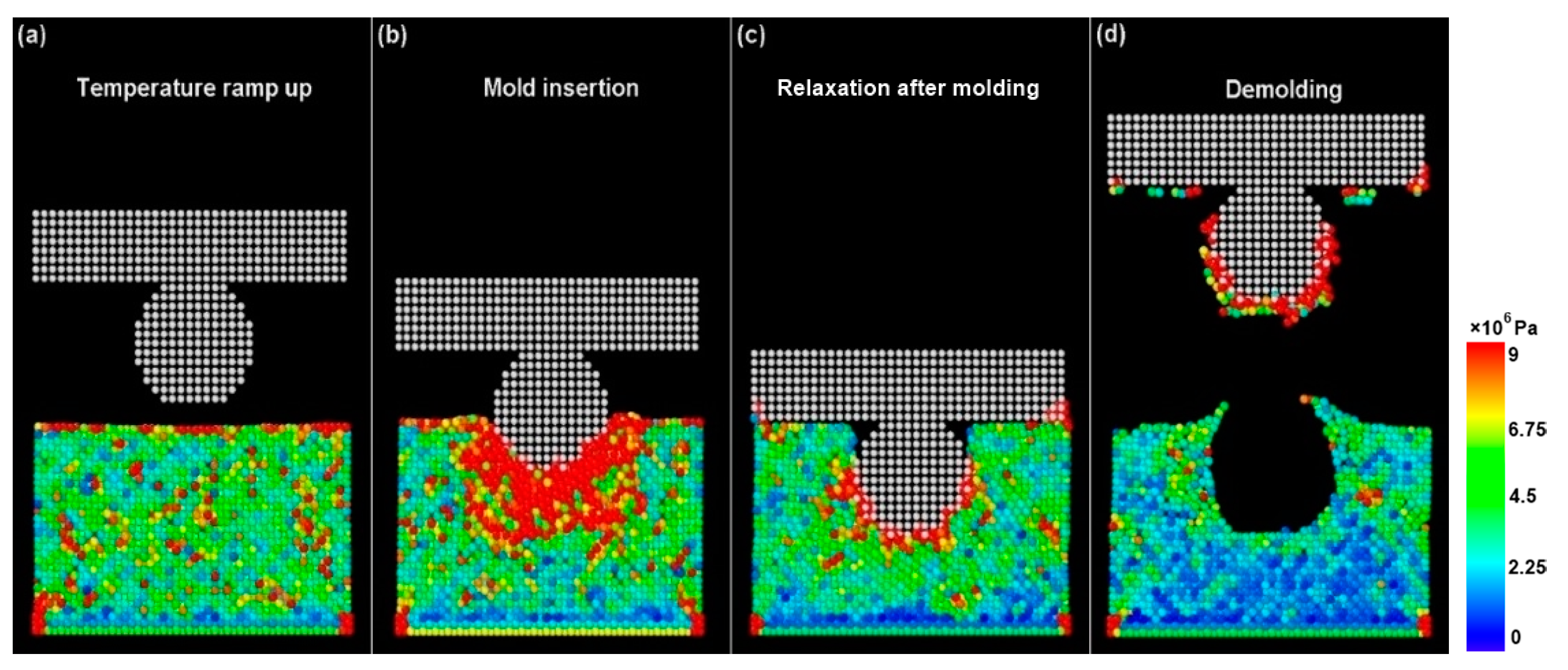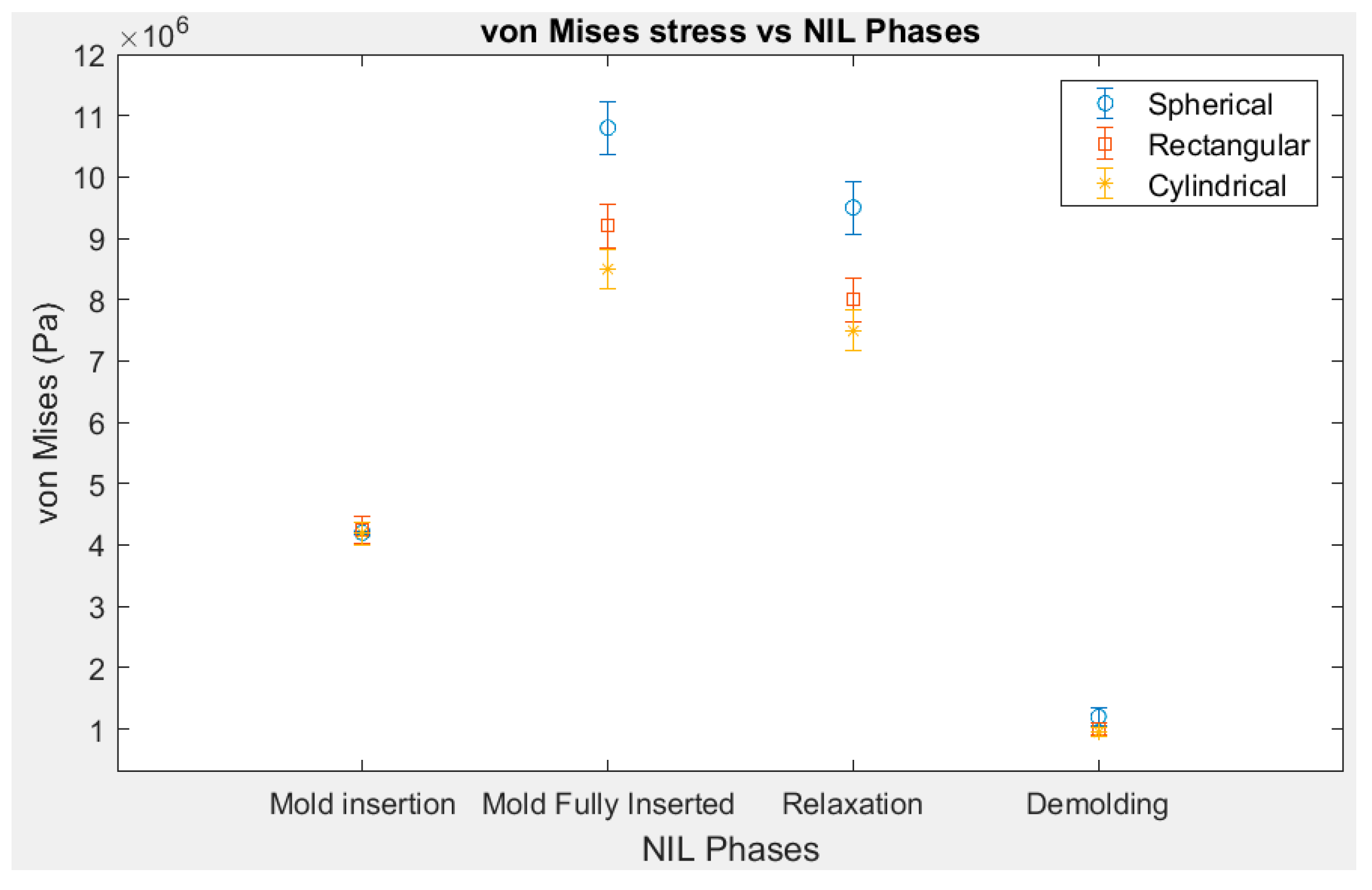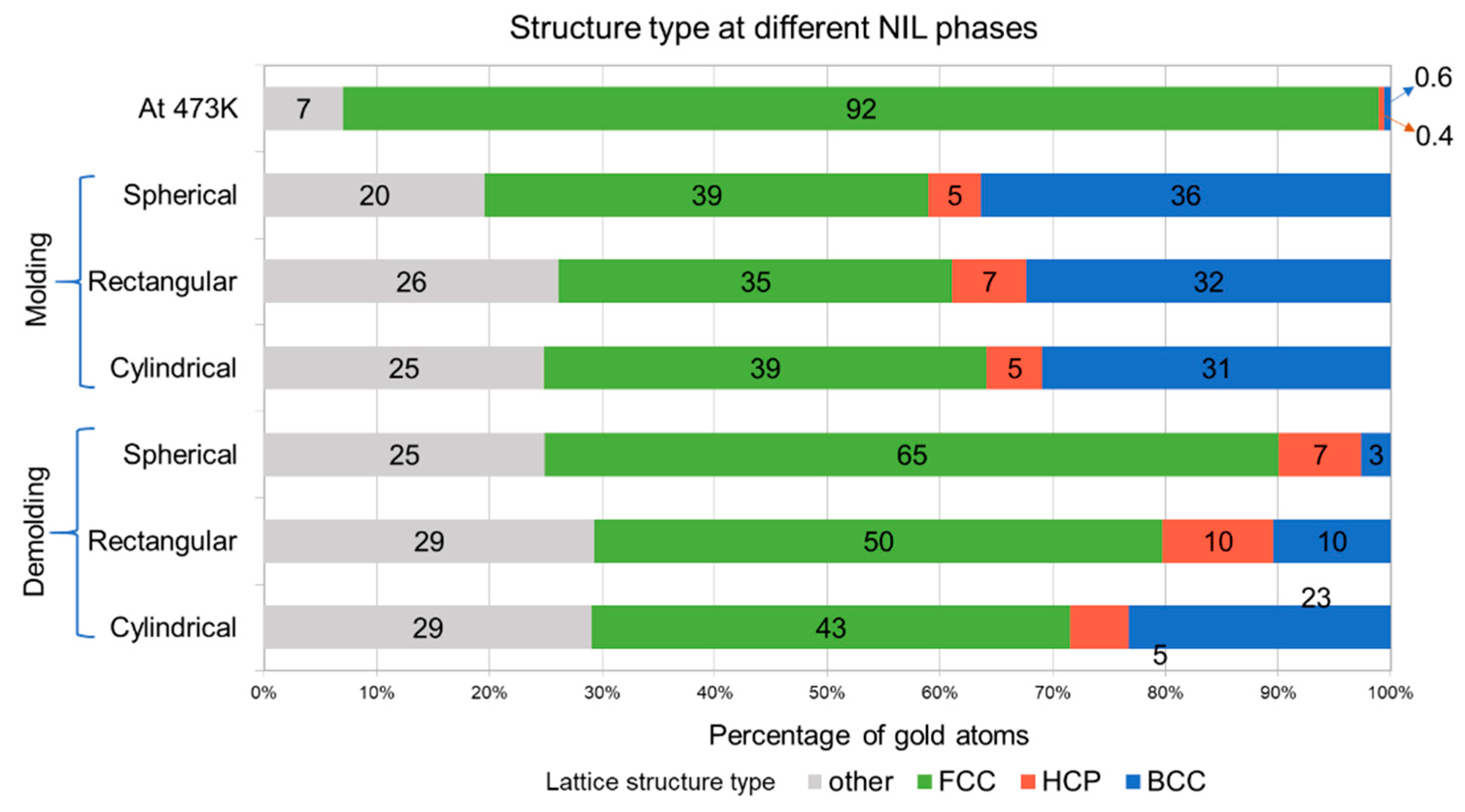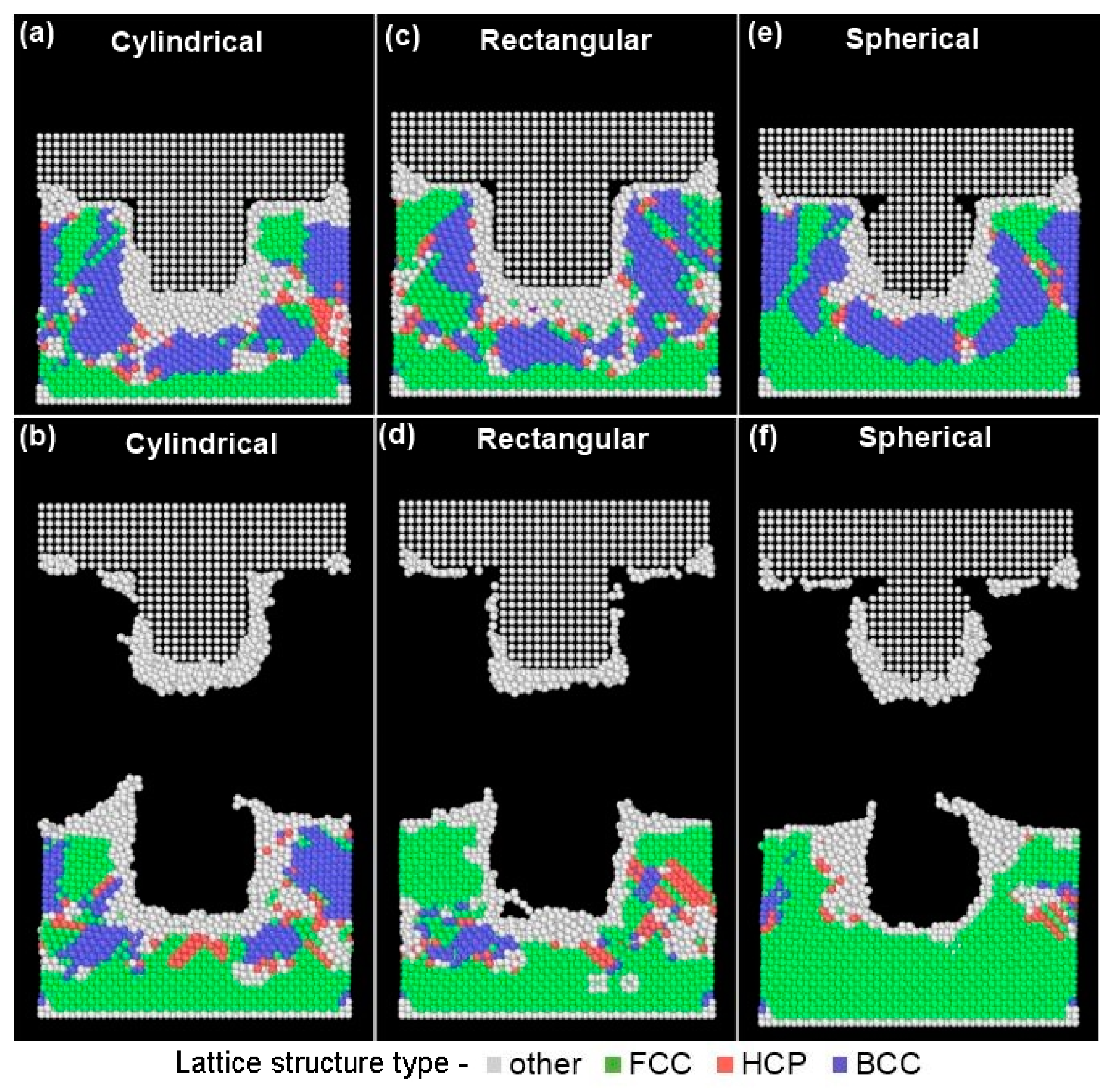Molecular Dynamics Investigation of the Deformation Mechanism of Gold with Variations in Mold Profiles during Nanoimprinting
Abstract
:1. Introduction
2. Materials and Methods
3. Results and Discussions
4. Conclusions
Author Contributions
Funding
Institutional Review Board Statement
Informed Consent Statement
Data Availability Statement
Conflicts of Interest
References
- Chou, S.Y.; Krauss, P.R.; Renstrom, P.J. Nanoimprint lithography. J. Vac. Sci. Technol. B Microelectron. Nanometer Struct. 1996, 14, 4129. [Google Scholar] [CrossRef]
- Gaikwad, A. Understanding Material Deformation Mechanism in Nanoimprint Lithography for Engineering and Medical Applications. Ph.D. Thesis, North Carolina Agricultural and Technical State University, Greensboro, NC, USA, 2020. [Google Scholar]
- Chou, S.Y. Sub-10 nm imprint lithography and applications. J. Vac. Sci. Technol. B Microelectron. Nanometer Struct. 1997, 15, 2897. [Google Scholar] [CrossRef]
- Pease, R.F.; Chou, S.Y. Lithography and Other Patterning Techniques for Future Electronics. Proc. IEEE 2008, 96, 248–270. [Google Scholar] [CrossRef]
- Chou, S.Y.; Krauss, P.R. Imprint lithography with sub-10 nm feature size and high throughput. Microelectron. Eng. 1997, 35, 237–240. [Google Scholar] [CrossRef]
- Ko, S.H.; Park, I.; Pan, H.; Grigoropoulos, C.P.; Pisano, A.P.; Luscombe, C.K.; Frechet, J.M.J. Direct Nanoim printing of Metal Nanoparticles for Nanoscale Electronics Fabrication. Nano Lett. 2007, 7, 1869–1877. [Google Scholar] [CrossRef]
- Buzzi, S.; Robin, F.; Callegari, V.; Löffler, J.F. Metal direct nanoimprinting for photonics. Microelectron. Eng. 2008, 85, 419–424. [Google Scholar] [CrossRef]
- Sealy, C. Road map to nanomanufacturing: Nanofabrication. Mater. Today 2005, 8, 7. [Google Scholar]
- Sun, H.; Yin, M.; Wang, H. High Aspect Ratio Nanoimprint Mold-Cavity Filling and Stress Simulation Based on Finite-Element Analysis. Micromachines 2017, 8, 243. [Google Scholar] [CrossRef] [Green Version]
- Tada, K.; Hirai, Y. Molecular Dynamics Study on Mold and Pattern Breakages in Nanoimprint Lithography. In Lithography; IntechOpen: London, UK, 2010. [Google Scholar]
- Jiang, W.; Ding, Y.; Liu, H.; Lu, B.; Shi, Y.; Shao, J.; Yin, L. Two-Step curing method for demoulding in UV nanoimprint lithography. Microelectron. Eng. 2008, 85, 458–464. [Google Scholar] [CrossRef]
- Quang-Cherng, H.; Chen-Da, W.; Te-Hua, F. Deformation Mechanism and Punch Taper Effects on Nanoimprint Process by Molecular Dynamics. Jpn. J. Appl. Phys. 2004, 43, 7665. [Google Scholar]
- Pei, Q.X.; Lu, C.; Liu, Z.S.; Lam, K.Y. Molecular dynamics study on the nanoimprint of copper. J. Phys. D Appl. Phys. 2007, 40, 4928–4935. [Google Scholar] [CrossRef]
- Yuan, Y.; Sun, T.; Zhang, J.; Yan, Y. Molecular dynamics study of void effect on nanoimprint of single crystal aluminum. Appl. Surf. Sci. 2011, 257, 7140–7144. [Google Scholar] [CrossRef]
- MacIntyre, D.; Thoms, S. A study of resist flow during nanoimprint lithography. Microelectron. Eng. 2005, 78–79, 670–675. [Google Scholar] [CrossRef]
- Hsiung, Y.H.; Chen, H.Y.; Sung, C.K. Temperature effects on formation of metallic patterns in direct nanoimprint technique—Molecular dynamics simulation and experiment. J. Mater. Process. Technol. 2009, 209, 4401–4406. [Google Scholar] [CrossRef]
- Odujole, I.J.; Desai, S. Molecular dynamics investigation of material deformation behavior of PMMA in nanoimprint lithography. AIP Adv. 2020, 10, 095102. [Google Scholar] [CrossRef]
- Odujole, J.; Desai, S. Atomistic Investigation of Material Deformation Behavior of Polystyrene in Nanoimprint Lithography. Surfaces 2020, 3, 649–663. [Google Scholar] [CrossRef]
- Odujole, J.; Desai, S. Molecular Dynamics Simulation of Poly Acrylic Acid as a Resist Material for Thermal Nanoimprint Lithography Processes. In Proceedings of the Industrial Engineers Research Conference, New Orleans, LA, USA, 1 October 2020. [Google Scholar]
- Akter, T.; Desai, S. Developing a predictive model for nanoimprint lithography using artificial neural networks. Mater. Des. 2018, 160, 836–848. [Google Scholar] [CrossRef]
- Almakaeel, H.; Albalawi, A.; Desai, S. Artificial neural network based framework for cyber nano manufacturing. Manuf. Lett. 2018, 15, 151–154. [Google Scholar] [CrossRef]
- Cordeiro, J.; Desai, S. The Leidenfrost Effect at the Nanoscale. J. Micro Nano Manuf. 2016, 4, 041001. [Google Scholar] [CrossRef] [Green Version]
- Hollingsworth, S.A.; Dror, R.O. Molecular Dynamics Simulation for All. Neuron 2018, 99, 1129–1143. [Google Scholar] [CrossRef] [PubMed] [Green Version]
- Rodrigues, J.; Desai, S. The nanoscale Leidenfrost effect. Nanoscale 2019, 11, 12139–12151. [Google Scholar] [CrossRef]
- Marquetti, I.; Desai, S. Orientation effects on the nanoscale adsorption behavior of bone morphogenetic protein-2 on hy-drophilic silicon dioxide. RSC Adv. 2019, 9, 906–916. [Google Scholar] [CrossRef] [Green Version]
- Marquetti, I.; Desai, S. Molecular modeling the adsorption behavior of bone morphogenetic protein-2 on hydrophobic and hydrophilic substrates. Chem. Phys. Lett. 2018, 706, 285–294. [Google Scholar] [CrossRef]
- Marquetti, I.; Rodrigues, J.; Desai, S.S. Ecological Impact of Green Computing Using Graphical Processing Units in Molecular Dynamics Simulations. IJGC 2018, 9, 35–48. [Google Scholar] [CrossRef]
- Cordeiro, J.; Desai, S. The Effect of Water Droplet Size, Temperature, and Impingement Velocity on Gold Wettability at the Nanoscale. J. Micro Nano Manuf. 2017, 5, 031008. [Google Scholar] [CrossRef]
- Gaikwad, A.; Clarke, J. Molecular Dynamics Study of the Quenching Effect on Direct Nanoimprint of Gold. In Proceedings of the 2019 IISE Annual Conference, Orlando, FL, USA, 18–21 May 2019; pp. 171–176. [Google Scholar]
- Zhang, J.; Zhang, Y.; Mara, N.; Lou, J.; Nicola, L. Direct nanoimprinting of single crystalline gold: Experiments and dislocation dynamics simulations. Appl. Surf. Sci. 2014, 290, 301–307. [Google Scholar] [CrossRef]
- Lebreton, C.; Wang, Z. Nanofabrication on gold surface with scanning tunneling microscopy. Microelectron. Eng. 1996, 30, 391–394. [Google Scholar] [CrossRef]
- Gaikwad, A.; Desai, S. Understanding Material Deformation in Nanoimprint of Gold using Molecular Dynamics Simulations. Am. J. Eng. Appl. Sci. 2018, 11, 837–844. [Google Scholar] [CrossRef] [Green Version]
- Gaikwad, A.; Odujole, J.; Desai, S. Atomistic investigation of process parameter variations on material deformation behavior in nanoimprint lithography of gold. Precis. Eng. 2020, 64, 7–19. [Google Scholar] [CrossRef]
- Kontio, J.M.; Husu, H.; Simonen, J.; Huttunen, M.J.; Tommila, J.; Pessa, M.; Kauranen, M. Nanoimprint fabrication of gold nanocones with 10 nm tips for enhanced optical interactions. Opt. Lett. 2009, 34, 1979–1981. [Google Scholar] [CrossRef]
- Manson, S.S.; Halford, G.R. Fatigue and Durability of Metals at High Temperatures; ASM International: Materials Park, OH, USA, 2009. [Google Scholar]
- Plimpton, S. Fast Parallel Algorithms for Short-Range Molecular Dynamics. J. Comput. Phys. 1995, 117, 1–19. [Google Scholar] [CrossRef] [Green Version]
- Alexander, S. Visualization and analysis of atomistic simulation data with OVITO—The Open Visualization Tool. Model. Simul. Mater. Sci. Eng. 2010, 18, 015012. [Google Scholar]
- Towns, J.; Cockerill, T.; Dahan, M.; Foster, I.; Gaither, K.; Grimshaw, A.; Hazlewood, V.; Lathrop, S.; Lifka, D.; Peterson, G.D.; et al. XSEDE: Accelerating Scientific Discovery. Comput. Sci. Eng. 2014, 16, 62–74. [Google Scholar] [CrossRef]
- Lee, S.; Park, S.; Cho, D.-I. The surface/bulk micromachining (SBM) process: A new method for fabricating released MEMS in single crystal silicon. J. Microelectromech. Syst. 1999, 8, 409–416. [Google Scholar]
- Rao, A.V.N.; Pal, P.; Pandey, A.K.; Menon, P.K.; Tanaka, H.; Sato, K. High Speed Silicon Wet Bulk Micromachining of Si {111} in KOH Based Solution. In Proceedings of the 2020 Symposium on Design, Test, Integration & Packaging of MEMS and MOEMS (DTIP), Lyon, France, 15–26 June 2020. [Google Scholar]
- Rao, A.V.N.; Swarnalatha, V.; Pandey, A.K.; Pal, P. Determination of precise crystallographic directions on Si {111} wafers using self-aligning pre-etched pattern. Micro Nano Syst. Lett. 2018, 6, 4. [Google Scholar]
- Feng, Y.; Yang, X.; Zhang, Z.; Kang, D.; Zhang, J.; Liu, K.; Li, X.; Shen, J.; Wang, T. Epitaxy of single-crystalline GaN film on CMOS-compatible Si (100) Substrate buffered by graphene. Adv. Funct. Mater. 2019, 29, 1905056. [Google Scholar] [CrossRef]
- Ryou, J.-H.; Yoder, P.D.; Liu, J.; Lochner, Z.; Kim, H.; Choi, S.; Kim, H.J.; Dupuis, R.D. Control of quantum-confined stark effect in InGaN-based quantum wells. IEEE J. Sel. Top. Quantum Electron. 2009, 15, 1080–1091. [Google Scholar] [CrossRef]
- Wagoner, R.H.; Lim, H.; Lee, M.-G. Advanced Issues in springback. Int. J. Plast. 2013, 45, 3–20. [Google Scholar] [CrossRef]
- Wu, C.-D.; Li, R.-E. Effects of alloy composition, cavity aspect ratio, and temperature of imprinted ZrCu metallic glass films: A molecular dynamics study. Appl. Phys. A 2020, 126, 209. [Google Scholar] [CrossRef]
- Kang, M.G.; Kim, M.-S.; Kim, J.; Guo, L.J. Organic solar cells using nanoimprinted transparent metal electrodes. Adv. Funct. 2008, 20, 4408–4413. [Google Scholar]
- Wu, J.; Lee, W.L.; Low, H.Y. Nanostructured Free-Form Objects via a Synergy of 3D Printing and Thermal Nanoim-printing. Glob. Chall. 2019, 3, 1800083. [Google Scholar] [CrossRef] [PubMed]
- Baskes, M.I. Modified embedded-atom potentials for cubic materials and impurities. Phys. Rev. B 1992, 46, 2727–2742. [Google Scholar] [CrossRef] [PubMed]
- Xia, W.; Su, Y.; Li, T.; Liu, C.; Li, D.; Duan, Z. Study of demolding in nanoimprint lithography with pseudoplastic metal nanoparticle fluids. RSC Adv. 2013, 3, 17851–17859. [Google Scholar] [CrossRef]
- Larsen, P.M.; Schmidt, S.; Schiøtz, J. Robust structural identification via polyhedral template matching. Model. Simul. Mater. Sci. Eng. 2016, 24, 055007. [Google Scholar] [CrossRef]
- Goubet, N.; Pileni, M.-P. Negative supracrystals inducing a FCC-BCC transition in gold nanocrystal superlattices. Nano Res. 2013, 7, 171–179. [Google Scholar] [CrossRef]
- Zhang, X.; Sun, C.; Fang, N. Manufacturing at Nanoscale: Top-Down, Bottom-up and System Engineering. J. Nanopart. Res. 2004, 6, 125–130. [Google Scholar] [CrossRef]
- Gray, G.T. High-Strain-Rate Deformation: Mechanical Behavior and Deformation Substructures Induced. Annu. Rev. Mater. Res. 2012, 42, 285–303. [Google Scholar] [CrossRef]
- Perumal, J.; Yoon, T.H.; Jang, H.S.; Lee, J.J.; Kim, D.P. Adhesion force measurement between the stamp and the resin in ultraviolet nanoimprint lithography—An investigative approach. Nanotechnology 2009, 20, 055704. [Google Scholar] [CrossRef]
- Wang, Y.M.; Cai, W. Evaluation of the Surface Tension of Silicon-Gold Binary Liquid Alloy. Mater. Sci. Forum 2015, 817, 772–777. [Google Scholar] [CrossRef]
- Engin, C.; Urbassek, H.M. Molecular-dynamics investigation of the fcc → bcc phase transformation in Fe. Comput. Mater. Sci. 2008, 41, 297–304. [Google Scholar] [CrossRef]
- Marder, M.P. Condensed Matter Physics; Wiley: Hoboken, NJ, USA, 2010. [Google Scholar]






| Element | Lattice Constant (Å) | Melting Point (K) | Density (kg/m3) | t(1) | t(2) | t(3) | α0 | β0 | β1 | β2 | β3 |
|---|---|---|---|---|---|---|---|---|---|---|---|
| Silicon | 5.431 | 1687 | 19300 | 3.30 | 5.10 | −0.80 | 4.87 | 4.8 | 4.8 | 4.8 | 4.8 |
| Gold | 4.065 | 1337 | 2328 | 1.58 | 1.50 | 2.60 | 6.34 | 5.45 | 2.2 | 6 | 2.2 |
Publisher’s Note: MDPI stays neutral with regard to jurisdictional claims in published maps and institutional affiliations. |
© 2021 by the authors. Licensee MDPI, Basel, Switzerland. This article is an open access article distributed under the terms and conditions of the Creative Commons Attribution (CC BY) license (https://creativecommons.org/licenses/by/4.0/).
Share and Cite
Gaikwad, A.; Desai, S. Molecular Dynamics Investigation of the Deformation Mechanism of Gold with Variations in Mold Profiles during Nanoimprinting. Materials 2021, 14, 2548. https://doi.org/10.3390/ma14102548
Gaikwad A, Desai S. Molecular Dynamics Investigation of the Deformation Mechanism of Gold with Variations in Mold Profiles during Nanoimprinting. Materials. 2021; 14(10):2548. https://doi.org/10.3390/ma14102548
Chicago/Turabian StyleGaikwad, Abhaysinh, and Salil Desai. 2021. "Molecular Dynamics Investigation of the Deformation Mechanism of Gold with Variations in Mold Profiles during Nanoimprinting" Materials 14, no. 10: 2548. https://doi.org/10.3390/ma14102548







